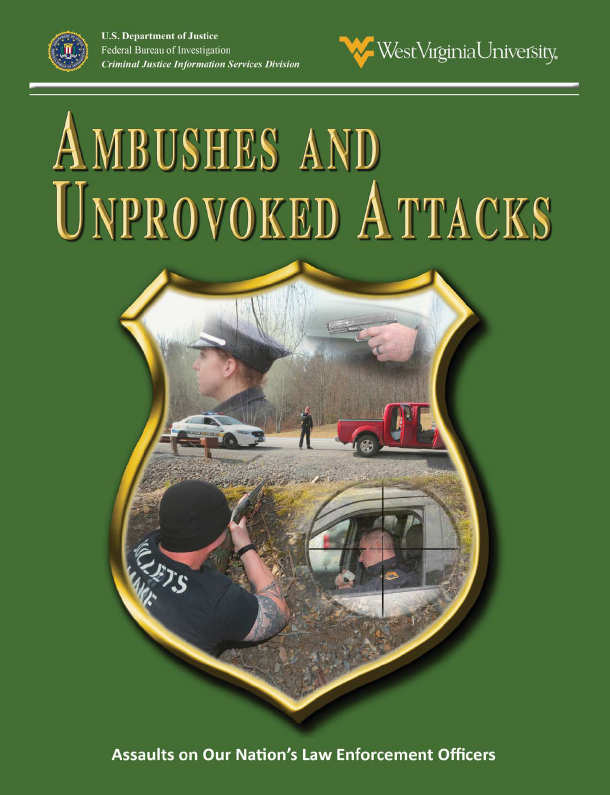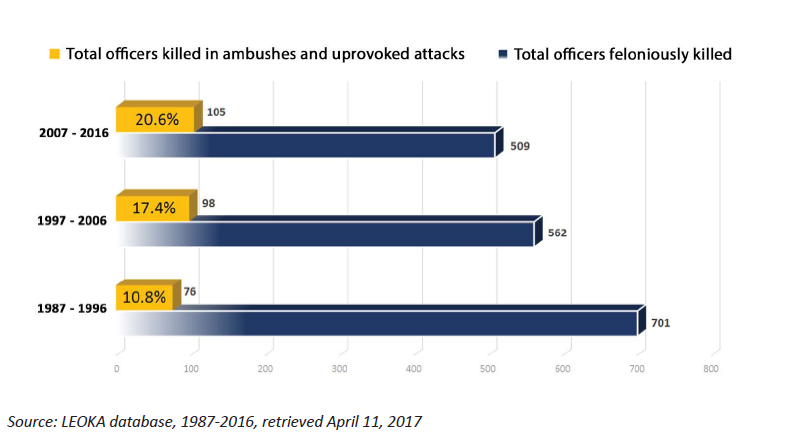Over a number of years, data collected by the FBI’s Law Enforcement Officers Killed and Assaulted {LEOKA} Program began to demonstrate an alarming trend in the number of officers who were killed in ambushes and unprovoked attacks. While the overall number of officers who were feloniously killed was declining, the percentage of officers feloniously killed during surprise attacks was increasing. The LEOKA Program launched a thorough examination of ambushes and unprovoked attacks in an effort to gain insight into the phenomenon and to provide information to enhance training programs for law enforcement officers. The research focused on the mindset and perceptions of officers involved and offenders who carried out those acts. In particular, why the incidents may have occurred and how those involved reacted to the situation.
Researchers selected incidents that met the LEOKA definitions for ambushes and unprovoked attacks, researched those cases, conducted in-depth interviews of officers and offenders involved in those incidents, and methodically analyzed the interview transcripts for useful information. Participants included both law enforcement officers and offenders who willingly agreed to participate. The officers had survived or witnessed an ambush or an unprovoked attack. The offenders had been tried and convicted of engaging in such incidents on one or more law enforcement officers.
Thirty-three officers were interviewed, and researchers identified several topics that officers frequently addressed when discussing the ambushes and unprovoked attacks. Some of the most commonly mentioned themes included: Ambushed {describing the attack}, Altered perceptions {during the incident} Backup, Reflections {lessons learned}, Post-incident-Social support, Ambush cognitions {thoughts during the incident}, Psychological impact, and injuries sustained.
Thirty offenders participated, and the LEOKA research team conducted interviews with them in various prisons throughout the United States. Most of the offenders were male {96.7 percent} and had a history of drug abuse {73.3 percent} and/or alcohol abuse {66.7 percent}. Fifty percent of the sample reported one or more suicide attempts in the past. The transcripts of the interviews with offenders demonstrated that many lived lives of stress and strain, often coming from unstable homes and engaging in criminal activities early in life. From the information gathered from the offenders, the research team identified five overall motives behind their attacks:
Personal-the overall motive for the ambush or unprovoked attack was for personal reasons (to accomplish a personal objective, e.g., avoiding arrest).
Expressive-the overall motive for the ambush or unprovoked attack was related to the offender’s emotionality or experience of crisis-including suicidality.
Economic-the overall motive for the ambush or unprovoked attack was for economic gain.
Political-the overall motive for the ambush or unprovoked attack was political reasons, or to make a political statement.
Social-the overall motive for the ambush or unprovoked attack was for social reasons. As a result of attacking the officer, an offender stood to gain social standing within his circle.
In addition, researchers identified micromotives from the offenders’ interviews. Micromotives are defined as biopsychosocial influences that set the stage for the ambush or unprovoked attacked. These influences could include “the offender’s worldview, or the actual needs, values, or desires that were involved” {Daniels et al., 2016, p. 252}. Examples of the most common micromotives include: Street life {prior criminal involvement}, Substance use {history of drug use}, Prepared for battle {access to or obtaining weapons}, Negative background as a minor {particularly family instability}, Mental state {including cognitive reactions and remorse}, and Escape {from the attack}.
Whatever the impetus for an ambush or unprovoked attack, it is not known ahead of time, and such assaults seem impossible to mitigate. Even so, the analysis of the interviews LEOKA staff conducted with officers and offenders found common subjects that can, at the very least, be discussed and, in some cases, addressed with training. LEOKA staff compiled a list of issues and training suggestions for officers. The discussion includes topics such as altered perceptual acuity, engaging offenders, mental preparation, communication, backup, and the will to survive. Officers also cited specific trainings that they felt directly contributed to their survival.
Several narratives describing ambushes and unprovoked attacks included in this study provide further insight into the situations and reactions of both the officers and the offenders. In eight of the cases reviewed, researchers were able to interview both the victim and/or witness officers and the offenders who perpetrated the ambushes or attacks. Two in-depth case studies present the context surrounding each incident and the viewpoints of both the officer and the offender. The presented perspectives demonstrate how different the officers’ perceptions of what happened were from the offenders’ perspectives.
The appendices present information about the methodologies used in the study, the LEOKA Program itself, and a discussion of human reactions to trauma. The last topic is particularly useful to place the themes of this study in context. In the aftermath of a traumatic event, such as being ambushed or involved in an unprovoked attack, humans respond on four primary levels: physiologically, psychologically, behaviorally, and spiritually. All of these aspects are interrelated, so a negative response in one area may have a negative impact in another area. Despite receiving injuries and being psychologically and spiritually traumatized, people can develop effective coping strategies by relying on the resources in their environment. Such resources may include family, friends, coworkers, the community, one’s religious/spiritual community and beliefs, and professional counselors and psychologists.
The officers, LEOKA staff, researchers from West Virginia University {WVU}, and others involved in this study have spent hundreds of hours in sharing and gathering information, reviewing thousands of pages of case reports and interview transcripts, and preparing the results. As many of the officers shared during their interviews, they hope their experiences will help other officers by impacting the discussion and training practices concerning these surprise assaults. While ambushes and unprovoked attacks cannot be prevented entirely, hopefully, with the help of what has been learned from this study, officers can go into the field with a greater understanding of why these attacks occur, specific circumstances in which they have occurred, and what some officers have done to survive the attacks and handle the aftermath.
…
…
QUANTlTATlVE ANALYSlS
Offender backgrounds
Gender
• 29 offenders were male.
• 1 co-offender was female
Race
• 12 offenders were Black or African-American.
• 9 offenders were White.
• 6 were Asian/Native Hawaiian/Other Pacific Islander.
• 2 were American Indian/Alaska Native.
• 1 offender did not report race.
Average ages
• 28 years old at the time of the attacks was the average age of the offenders.
• Offenders’ ages ranged from 16 to 55 years.
Education
• 18 offenders reported they had a General Educational Development {GED®} certificate or a high school diploma. o 12 of the 18 held a GED®.
o 6 held a high school diploma.
• 9 offenders neither graduated from high school nor earned a GED®.
• 3 offenders did not report their educational level.
Military service
• 18 offenders reported they never served in the military.
• 1 offender reported military service with an honorable discharge.
• 11 offenders did not respond to this question.
Employment
• 17 offenders reported they were employed at the times of the assaults. o 4 were laborers.
o 1 was a technician.
o 1 was in a service occupation
o 11 offenders described their employment as “other.”
• 1 offender was a student
• 10 offenders were unemployed.
• 2 offenders did not respond to this question.
Youth and home life growing up
Parents
• 15 offenders reported growing up with a father present.
• 14 stated that their fathers were either mostly absent or had never lived with them.
• 26 lived with their mothers most of the time.
• 2 never lived with their mothers.
• 18 offenders stated they had warm and close relationships with their mothers growing up.
• 7 reported their relationships with their mothers to be cold and distant or hostile and aggressive.
• 12 offenders reported warm and close relationships with their fathers.
• 10 reported negative relationships with their fathers.
• 5 reported variable relationships with their fathers.
• 3 offenders did not respond to this question.
Mental health and placements
• 4 offenders said they experienced physical abuse.
• 7 experienced psychological abuse.
• 12 offenders reported they ran away from home at some time during their youth.
• 6 stated they had been thrown out of the homes before the age of 18.
• 10 of the offenders were institutionalized during their adolescence. o 3 were placed in orphanages or state homes.
o 2 were placed into the foster care system. o 5 reported “other.”
o 5 offenders stated that they were first institutionalized between the ages of 14 and 15 years. o 2 offenders were first institutionalized between the ages of 12 and 13 years.
o 2 offenders reported they were institutionalized at age 11 or younger.
o 1 offender reported he or she was first institutionalized at age 16 or older.
Substance abuse by caregivers
• 12 offenders reported known or suspected substance abuse by their fathers.
• 3 reported known or suspected substance abuse by their mothers.
• 5 of the offenders reported known drug abuse by their fathers.
• 5 reported known drug abuse by their mothers.
Substance abuse by offenders
Of the 30 offenders, 25 said they had a history of regularly consuming alcohol.
• 20 offenders reported drinking between once per week to daily.
• 14 reported consuming 4 to 11 or more drinks in each instance.
• 22 offenders reported regular use of illicit drugs prior to the attacks.
o Frequency of use ranged from 2 uses per week to daily use. o Marijuana was the most commonly used drug.
o 2 offenders reported they exclusively used marijuana.
o 7 offenders engaged in polysubstance abuse, which included marijuana plus a variety of other drugs.
When researchers asked offenders if they had ever committed a crime in order to get money for drugs:
• 13 of the 30 offenders said they had never committed a crime to get money for drugs.
• 8 offenders said they had committed crimes to get money for drugs.
• 9 offenders either reported no drug use or did not answer the question.
Suicide
• 15 of the 30 offenders reported they had attempted suicide one or more times prior to the ambush.
• The number of attempts reported for each offender ranged from 1 attempt to as many as 20 attempts.
Prior criminal involvement
Offenders in this study reported numerous encounters with law enforcement prior to the ambush or unprovoked attack.
Age of offenders when they first committed a crime.
• 14.5 years old was the average age the offenders first committed a crime, with a range from 6 to 25 years old.
• 10 of the offenders reported being involved in confrontations with law enforcement officers before being involved in the incidents in this study.



